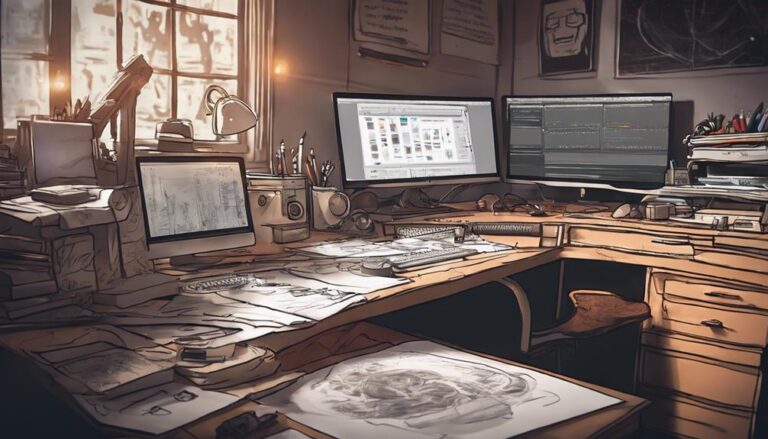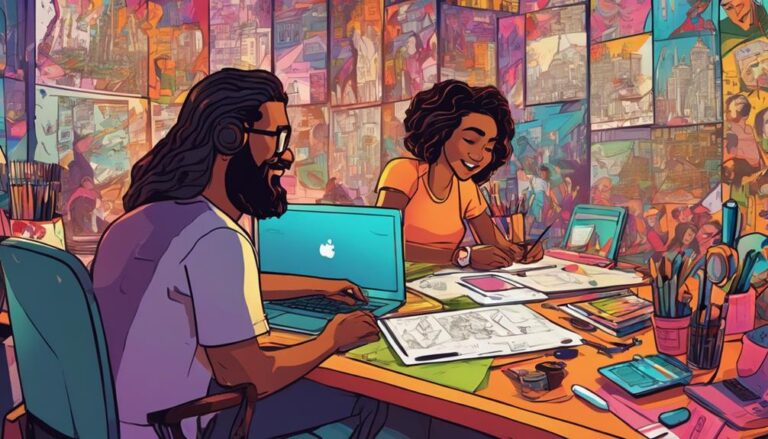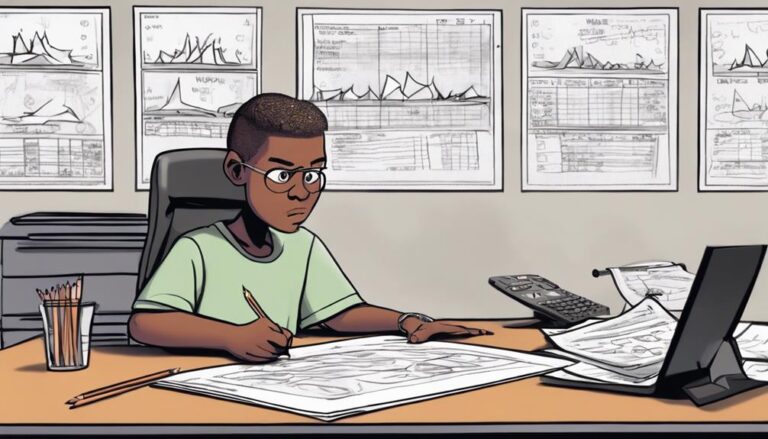What Makes a Memorable Cartoon Character?
As you think back to your favorite cartoon characters, what is it about them that has stuck with you all these years? Is it their lovable quirks, their bold design, or the way they seem to leap off the screen with their unique personalities? Whatever it is, it's clear that something about these characters has resonated with you, and it's likely that you're not alone. But what exactly goes into creating a character that's truly unforgettable? Let's explore the key elements that bring these beloved characters to life and discover what makes them so memorable.
Key Takeaways
- A lovable goofball personality with quirks and flaws makes a cartoon character relatable, lovable, and memorable.
- A unique visual identity, including iconic silhouettes, expressive postures, and bold design choices, sets a character apart.
- Consistency in personality, traits, and visual design elements creates a cohesive look and feel that's instantly recognizable.
- A rich backstory and emotional connection with the audience, including moral complexity and inner vulnerability, make a character feel fully realized.
Unique Personality Traits Matter
You can't help but be drawn to a cartoon character who's a lovable goofball one minute and a fearless hero the next, and it's their unique personality traits that make them truly unforgettable.
Their quirks and flaws are what make them relatable and lovable. Think about it – would you rather watch a perfect, cookie-cutter character or someone who trips over their own feet and still manages to save the day?
It's the imperfections that make them human, and it's their quirky humor that makes us laugh and root for them.
Comedic flaws are essential in creating a memorable character.
Who can forget the bumbling antics of Looney Tunes' Bugs Bunny or the hapless optimism of SpongeBob SquarePants? Their flaws are what make them endearing and hilarious.
By embracing their imperfections, you can create a character that audiences will adore and remember long after the credits roll.
Designing Characters With Distinction
Now that we've established that a character's imperfections are what make them lovable, it's time to bring those quirks to life through design, where a few bold strokes and deliberate style choices can turn a forgettable face into a truly iconic one.
You're about to create a visual identity that screams 'this character is one-of-a-kind!' Iconic silhouettes, like Mickey Mouse's ears or Bart Simpson's spiky hair, are instantly recognizable and can be replicated in various forms, from logos to merchandise.
But it's not just about the shape; Expressive postures can also make your character stand out. Think of SpongeBob SquarePants' enthusiastic poses or Tweety Bird's sassy stances. These deliberate design choices can convey a character's personality without needing a single line of dialogue.
The Power of Relatability Factor
You're probably wondering what makes a cartoon character stick with you long after the credits roll.
It's because they've got something that resonates with you – something that makes you go, 'Hey, I've been there too!' or 'That's so me!'
That's the power of relatability, and it's time to explore how universal human emotions, shared life experiences, and common personality traits can make a character truly unforgettable.
Universal Human Emotions
One universal language that transcends age, culture, and species is the emotional spectrum, which is why cartoon characters that tap into it can become instantaneously relatable and memorable.
You can't help but identify with a character who's feeling the same emotions you do. It's like they're speaking your language, and that's when the emotional resonance kicks in.
You start to empathize with them, and before you know it, you're invested in their journey.
When a character's emotional struggles mirror your own, it creates an empathy factor that's hard to ignore.
You've been there, done that, and got the t-shirt. You know exactly how they're feeling, and that connection is what makes them unforgettable.
Think of SpongeBob's optimism, Bart Simpson's mischievousness, or even Mickey Mouse's innocence – they all tap into universal human emotions that resonate with you on a deep level.
By doing so, they become more than just cartoon characters; they become old friends you can't help but root for.
Shared Life Experiences
As you sit back and reflect on your favorite cartoon characters, chances are you'll find that the most relatable ones are those who've shared in life's little struggles and triumphs that you've experienced yourself.
Think about it – don't you love watching Bugs Bunny outsmart Elmer Fudd because you've been in situations where you felt like you'd to outwit a pesky sibling or classmate? Or, don't you root for SpongeBob SquarePants when he's trying to get his boating license because you remember the thrill of learning to ride a bike or drive a car for the first time?
These shared life experiences create a bond between you and the character, making them more memorable and endearing.
Cartoon characters who struggle with inner doubts or childlike innocence resonate with us because we've been there too.
Who hasn't felt like Charlie Brown when they've struck out in life or faced rejection? Or, who hasn't experienced the wide-eyed wonder of a kid on Christmas morning, just like Buddy the Elf?
Common Personality Traits
Beyond their bright colors and wacky antics, it's the lovable quirks and flaws that make cartoon characters truly relatable, like when Daffy Duck's jealousy gets the better of him or when Tweety Bird's sassiness saves the day. You find yourself chuckling at their quirky humor and rooting for them despite their lovable flaws. This relatability factor is what makes them truly memorable.
Impulsiveness is a common trait, think Bugs Bunny's carrot-chasing sprees or Tom Cat's hare-brained schemes to catch Jerry.
Overconfidence is another, remember when Peter Griffin from Family Guy thinks he can fly, or when Homer Simpson believes he can fix anything with duct tape?
Naivety is also prevalent, who can forget SpongeBob SquarePants' innocent enthusiasm or Winnie the Pooh's simple, childlike wonder?
Sarcastic wit is a characteristic of many cartoons, like The Simpsons and Adventure Time, which are full of characters with quick, clever comebacks.
Good-heartedness is a trait that most cartoon characters possess, despite their flaws, making them lovable and endearing to audiences.
These traits not only make cartoon characters relatable but also add depth and humor to their stories.
Backstory and Character History
You're about to plunge into the delightfully dysfunctional family dynamics that forged this beloved cartoon character's personality, a backstory so jam-packed with zany relatives and harebrained hijinks that it's a wonder they turned out semi-sane. The formative events that shaped their worldview, the pivotal moments that triggered their quirks, and the weird, wacky, and wonderful experiences that molded their psyche are all vital elements of their character history.
| Formative Event | Impact on Character |
|---|---|
| Being raised by a family of eccentric inventors | Encouraged creativity and resourcefulness |
| Surviving a catastrophic kitchen explosion | Led to a lifelong fear of cooking |
| Having a pet dragon as a childhood companion | Fostered empathy and a sense of responsibility |
These pivotal moments in their backstory not only explain their motivations and behaviors but also make them relatable, endearing, and memorable. By fleshing out their character history, you'll create a rich tapestry of experiences that inform their every move, making them feel like a fully realized person rather than a one-dimensional caricature. So, immerse yourself in the wonderful world of their backstory and watch your character come alive!
Consistency Is Key Element
You're probably wondering what makes a cartoon character truly unforgettable, and the answer lies in consistency!
When you create a character, you're building a brand, and consistency is the glue that holds it all together.
From visual cues to personality quirks, it's the little details that make your character feel like an old friend, and we're about to explore the essential elements that'll make your creation truly iconic!
Visual Continuity Matters
As you conjure up the image of your favorite cartoon character, notice how every detail, from the shape of their nose to the swish of their tail, is meticulously consistent across every episode, comic strip, and merchandise item, reinforcing their iconic identity. This visual continuity is what makes them instantly recognizable and memorable.
Color harmony is the careful selection of colors that complement each other, creating a cohesive look that's both pleasing to the eye and synonymous with the character's personality.
Visual flow is the strategic placement of visual elements, guiding the viewer's attention through the character's design and creating a sense of movement and energy.
Proportion and scale involve the consistent use of proportions and scale, ensuring that the character's features and body language are always in harmony.
Texture and pattern refer to the thoughtful incorporation of textures and patterns, adding depth and visual interest to the character's design.
Facial expressions encompass the range of emotions conveyed through the character's facial expressions, making them relatable and endearing to audiences.
Established Character Traits
Consistently, your beloved cartoon character's quirky personality, mannerisms, and catchphrases are expertly woven throughout every storyline, making their unique identity unmistakable and unforgettable.
You know exactly what to expect from them, and that's what makes them so lovable! Their core values and moral compass are clear, guiding their actions and decisions, and creating a sense of reliability.
You trust that they'll always try to do the right thing, even if it doesn't always work out as planned.
This consistency is pivotal in making your character relatable and endearing. You can't help but root for them as they navigate through challenges and obstacles.
Their established traits also provide a sense of comfort and familiarity, making you feel like you're revisiting an old friend.
And let's be honest, who doesn't love a character who's unapologetically themselves?
When your character's traits are consistent, you can bet your audience will be hooked, enthusiastically anticipating their next move and quoting their catchphrases for days.
Recognizable Design Elements
What makes your beloved cartoon character instantly recognizable, even in a crowded scene, is their distinctive visual identity, which is carefully crafted from a unique blend of colors, shapes, and accessories that are unmistakably theirs. This consistency is key to making them memorable and lovable.
Their Iconic Silhouettes are so unique that you can identify them from a distance, even in a crowded room or a chaotic scene.
Their Color Schemes are bold, vibrant, and instantly recognizable – think SpongeBob's optimistic yellow or Mickey's iconic red shorts.
Their accessories, like hats, glasses, or jewelry, add a touch of personality and whimsy to their overall design.
The way they move, with their signature gestures and postures, brings their character to life.
Even their facial expressions, with their exaggerated emotions and reactions, make them relatable and endearing.
Voice Acting Magic Happens
How do you bring a cartoon character to life – a being that's equal parts sass, humor, and heart – without the magic of voice acting? It's the secret sauce that turns a 2D drawing into a living, breathing personality. A talented voice actor can make your character relatable, lovable, and memorable.
| Character Trait | Voice Acting Technique | Effect on Audience |
|---|---|---|
| Sassiness | Vocal range exploration: using high and low pitches to convey attitude | You'll laugh and roll your eyes in amusement |
| Humor | Timing and pacing: delivering punchlines with perfect comedic flair | You'll chuckle and crave more |
| Heart | Accent authenticity: using regional accents to add depth and emotion | You'll empathize and feel invested |
| Quirkiness | Voice inflections: adding unique sounds and mannerisms to the voice | You'll be fascinated and curious |
| Confidence | Projection and volume control: using loud and soft tones to convey authority | You'll be inspired and motivated |
With voice acting magic, your cartoon character transforms into a believable, lovable friend. It's the key to making your audience connect, care, and remember your character long after the credits roll.
Cultural Relevance and Timing
As you craft your cartoon character, you're not just creating a personality, you're tapping into the cultural pulse of the moment, ensuring your character's relevance and relatability resonate with audiences. You're not just drawing a face, you're holding up a mirror to society, reflecting the world we live in, and commenting on it.
Tap into current events: Use your character to comment on hot topics, like environmental issues or social justice movements.
Reflect diverse perspectives: Incorporate characters from different racial, ethnic, and cultural backgrounds to reflect the world we live in.
Poke fun at societal norms: Use humor to highlight the absurdity of certain cultural expectations or traditions.
Explore historical context: Draw inspiration from historical events, figures, or movements to add depth and meaning to your character.
Stay woke to pop culture trends: Keep your character current by referencing popular music, movies, or memes.
Emotional Connection and Depth
Your cartoon character's emotional resonance is the secret ingredient that turns a mere drawing into a beloved companion, one that audiences can't help but root for, laugh with, and empathize with on a deep, gut-level.
It's what makes you feel like you're right there with them, experiencing their highs and lows, and celebrating their triumphs.
To create this emotional connection, you need to give your character moral complexity – they shouldn't be purely good or evil, but rather a mix of both.
This moral gray area makes them relatable and human.
But that's not all – your character also needs inner vulnerability.
What're their deepest fears, desires, and motivations?
What makes them tick?
When you expose these vulnerabilities, you create a sense of authenticity that audiences can't resist.
Think of it like this: your character's emotional resonance is like a delicious layer cake – moral complexity is the rich frosting, and inner vulnerability is the moist, fluffy center.
When you combine the two, you get a character that's impossible to forget.
Frequently Asked Questions
Can a Character Be Memorable With a Complex Design?
You wonder if a character can be memorable with a complex design, but let's be real, too much visual clutter can overwhelm! Visual simplicity and design balance are key to making your character pop, not get lost in the noise.
How Much Backstory Is Too Much for a Character?
"You're tempted to spill your character's entire life story, but beware: too much backstory can overwhelm audiences and suffocate character relatability. Stop at the sweet spot where mystery meets intrigue, and let your character's personality shine!"
Do Animated Characters Translate Well to Live-Action?
When you imagine your favorite toons in a live-action cinematic adaptation, do you wonder if they'll retain their magic? Can a faithful representation of their quirky charm be achieved, or will it fall flat in the real world?
Can a Character Be Memorable Without a Catchphrase?
You don't need a catchphrase to make a character unforgettable – think of silent humor like Charlie Chaplin or a vocal quirk like Daffy Duck's lisp, which can be just as memorable and endearing!
Are Memes a Key to a Character's Memorability?
You're wondering if memes are the secret sauce to making a character unforgettable? Well, let's face it, a meme's got to have meme longevity and cultural relevance to stick in our minds – and yours truly, is no exception!
Conclusion
As you conjure up your own cartoon character, remember that it's the quirks, flaws, and contradictions that'll make them unforgettable.
Give them a dash of relatability, a pinch of emotional depth, and a whole lot of personality.
Then, sprinkle in some consistency, cultural relevance, and a voice that pops.
Voilà! Your character will leap off the screen, ready to capture hearts and minds.
The perfect blend of imperfections and awesomeness will turn them into a beloved friend, making them truly unforgettable.







